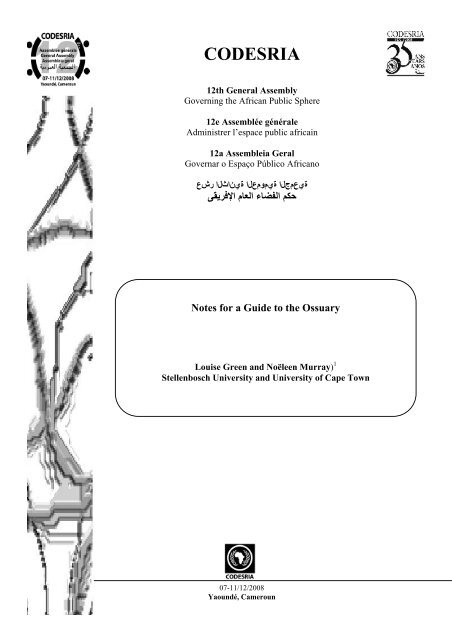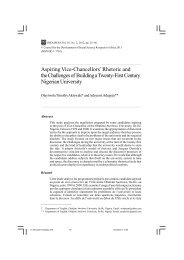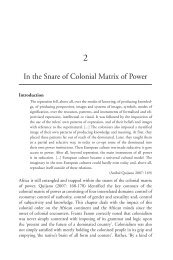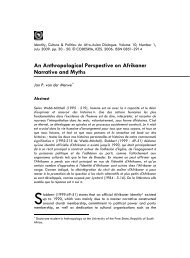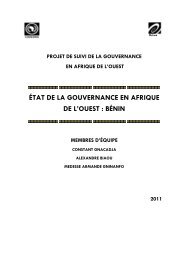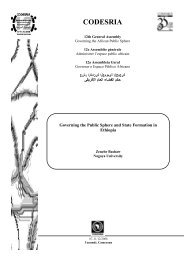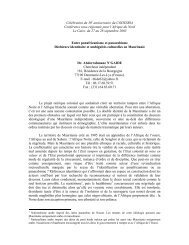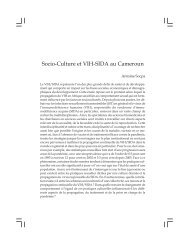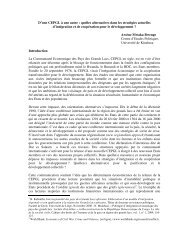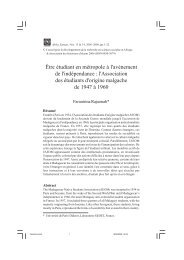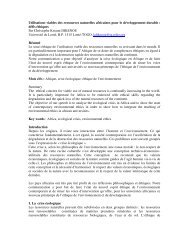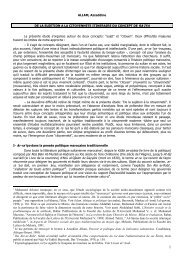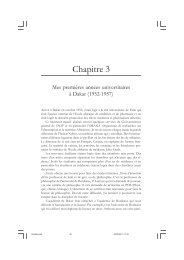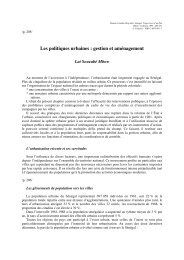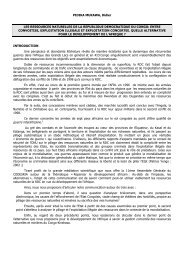Louise GREEN, Noeleen Frances MURRAY-COOKE - Codesria
Louise GREEN, Noeleen Frances MURRAY-COOKE - Codesria
Louise GREEN, Noeleen Frances MURRAY-COOKE - Codesria
You also want an ePaper? Increase the reach of your titles
YUMPU automatically turns print PDFs into web optimized ePapers that Google loves.
CODESRIA<br />
12th General Assembly<br />
Governing the African Public Sphere<br />
12e Assemblée générale<br />
Administrer l’espace public africain<br />
12a Assembleia Geral<br />
Governar o Espaço Público Africano<br />
عشر الثانية العمومية الجمعية<br />
ﻰﻘﻳﺮﻓﻹا مﺎﻌﻟا ءﺎﻀﻔﻟا ﻢﻜﺣ<br />
Notes for a Guide to the Ossuary<br />
<strong>Louise</strong> Green and Noëleen Murray) 1<br />
Stellenbosch University and University of Cape Town<br />
07-11/12/2008<br />
Yaoundé, Cameroun
<strong>Louise</strong> Green (Stellenbosch University) and Noëleen Murray (University of Cape Town) 1<br />
This essay explores the conflictual relationship between private property and public space in<br />
the reconfiguring of the city of Cape Town in postapartheid South Africa. It focuses on one<br />
specific building, an ossuary, built by the Cape Town City Council to house the bones of<br />
some of the city’s displaced dead. This ossuary, named the New Prestwich Memorial<br />
Building, provides a useful focus for addressing some of the complex ways in which ‘human<br />
remains’ emerge as one of the loci for the public expression of resistance to a developerdriven<br />
property market in postapartheid South Africa. The bones to be housed in this ossuary,<br />
though themselves mute, have set in motion an on-going and frequently hostile set of<br />
conversations in which the new dimensions of South Africa’s public sphere are being<br />
negotiated.<br />
Our reading of the New Prestwich Memorial Building sees it as a surface within the city of<br />
Cape Town that requires decoding. 2 It was built in 2007 to make material reparation for the<br />
city’s ‘emergency exhumation,’ before public consultation, of skeletal remains from a<br />
building site in Green Point, adjacent to the city centre and consequently what is frequently<br />
described as ‘prime property’. 3 The bones, variously reported to number in the thousands,<br />
were discovered during the building of a luxury new apartment block called The Rockwell<br />
and became the centre of an immense city-wide dispute. 4<br />
These unnamed and unmarked dead became the tangible signs of the city’s displacement of so<br />
many others, both living and dead. They highlighted the city’s sedimentation in an<br />
unreconstructed colonial past and its fantasied participation in a global future. They came to<br />
stand for everything which is overlooked, hidden, elided and displaced in the construction of<br />
the new global tourist city of Cape Town. 5<br />
The phrase in the title of this essay, ‘notes towards a guide’ may at first seem puzzling. Like<br />
almost all public memorials, The New Prestwich Memorial Building already contains a guide<br />
in the form of an exhibition of images and texts. In these, the building is described an<br />
Interpretative Centre. The exhibition includes a series of boards that describe the history of<br />
the area. The boards display maps, provide quotations from archival sources, offer<br />
information about early plans and developments in the city, and describe from archival<br />
2
sources everyday life in District 1. 6 The exhibition also includes a board describing the history<br />
of the dispute itself.<br />
The exhibition, following the genre of such guides, manages the experience of the space. It<br />
consigns the bones respectfully but decisively to the realm of heritage. Our guide offers<br />
something less official. It emerges out of our own deliberate attempt to engage with the site as<br />
a landscape in history - incomplete, troubling and under construction. Remembering the texts<br />
written about the dispute, conversations had and overheard, television, newspaper and<br />
magazine coverage, colloquia we had attended, we walked from the now completed though<br />
not fully occupied Rockwell across the road and down three blocks to the site of the Ossuary<br />
and we noted the elements in the visual landscape that alerted us to the work being done by<br />
this combination of material substances and design. We attempted to read what the building<br />
was saying, what it was concealing and how it interacted with the city surrounding it. We<br />
reflected on what role it was performing and to what extent was it closing down public debate<br />
through the structuring of public space.<br />
Our guide is imagined not as a systematic analysis of the site or an exhaustive survey of the<br />
issues relating to heritage, transformation and the city that the events surrounding the bones<br />
made visible. Instead through choosing the form of the essay, we wish to respond to the<br />
demands of the Ossuary as a material subject. In ‘The essay as form,’ cultural theorist<br />
Theodor Adorno suggests that what is valuable about the essay is its ability to trace the<br />
contours of a particular subject without imposing on it the forms demanded by disciplinary<br />
knowledge. He writes about the essay that ‘it thinks in fragments just as reality is fragmented<br />
and gains its unity only by moving through the fissures, rather than by smoothing over them’. 7<br />
Our essay takes the form of notes appended to various aspects of the materiality of the<br />
structure.<br />
These notes are structured around six words or phrases that we found at the site, part of the<br />
written text through which the official guide directs the visitor’s interpretation of the<br />
landscape. These words and phrases appeared to us to mark moments of intense<br />
symbolization, signifiers in which the ideological work of the architect and the authors of the<br />
exhibition became most visible. They represent points of entry into this heavily symbolically<br />
overlaid landscape. Removed from their comfortable position in various disciplinary modes of<br />
3
description, these words become interpretative devices through which it might be possible to<br />
open up cracks in the surface not only of the memorial itself but also of the city as a whole. 8<br />
They are: Gateway; ‘Engraved Palimpsest’; Mirrors; Visitors’ Book; Rock, Brick, Concrete;<br />
and Closed<br />
1. Gateway<br />
In the period post 1994 municipalities, much like many other institutions, in South African<br />
cities have been through a period of transformation, focusing on ‘restructuring’. New urban<br />
policies have been drafted aimed at enabling local authorities to govern cities in a more<br />
equitable manner. 9 However, these local authorities have been slow to implement new<br />
policies. In Cape Town in particular, a city wracked by political infighting and changes in<br />
governance, the period of transformation has seen city management in disarray. It is within<br />
this context that applications were made by a developer to build new luxury apartments in<br />
Prestwich Street, in the fast gentrifying area of Green Point. The official in charge of<br />
‘heritage’ signed a demolition order for a warehouse in an area that was well known to<br />
archaeologists and historians to contain sites of burial. 10<br />
The ensuing public dispute over the proposed development at Prestwich Street therefore<br />
started with a legal claim against the city over the granting of this order by the developer. 11<br />
Throughout the more visible process of dispute in which local community groups became<br />
vocal about the ‘bones’ of Prestwich Street, another battle was being fought over the property<br />
rights of the developer against the city council, which the developer ultimately won after a<br />
lengthy process of appeal. 12 The Prestwich Memorial was ultimately built on less<br />
commercially valuable land nearby which belonged to the City Council as an ‘act of<br />
conciliation’. The awkward triangular piece of ground (which contains an electrical substation,<br />
around which the memorial is built) has been reconceptualized as a ‘Gateway’. 13<br />
In the display devoted to the building itself, the architect, Lucien Le Grange, uses this term to<br />
describe the building. He writes ‘Perceived as a series of walls into which – and behind which<br />
– the recovered skeletal remains are stored, the building constitutes a strong edge along<br />
Somerset road and insodoing defines a ‘gateway’ into the Green Point precinct.’ 14 Reading<br />
this allows the great black grid-work that covers the large sliding doors at the front and the<br />
rear and even the side of the building to come into focus. Not only does this provide the<br />
4
uilding with impressive if perhaps somewhat unnecessary security. It also signifies a gate,<br />
which is, at the moment, closed.<br />
On our visit we entered through a small side entrance concealed behind a small brick<br />
extension. In order to enter our guide had to shift slightly a pile of things belonging to the<br />
workers who are currently maintaining the grounds. They had placed their things here because<br />
it appears so secluded, so out of the way of general traffic. Once inside the structure becomes<br />
even clearer. If all three sliding doors and grid-work frames were slid back it would be<br />
possible for a small crowd to walk through the building, in one end and out the other.<br />
In one of the displays, ‘About the exhibition’, the openness of this space is emphasized. 15 The<br />
displays currently situated in the space between the doors are described as temporary, able to<br />
be moved aside if the occasion demands it. The building makes itself available for symbolic<br />
ritual in the abstract by maintaining a degree of blankness, a certain, careful neutrality.<br />
Yet what would be the significance of passing through this ‘Gateway’? What is the<br />
significance of a gate which is not attached to a wall or impassable boundary of some kind?<br />
Does the presence of the Gateway imply a boundary, invisible possibly but one which the city<br />
wishes to map, mark and control.<br />
The idea of a gateways in current planning discourses in Cape Town perhaps also seeks to<br />
express a nostalgia for a different, older ordering of space, as defined by the colonial city,<br />
neatly bounded between the outer streets of Buitengracht and Biutenkant Streets. It suggests a<br />
city on a different scale, designed for pedestrian mobility not the standardized road system of<br />
the motor vehicle. The reinscribing of ‘gateways’ in the city suggests the desire to express the<br />
existence of variation within the city, of non-homogeneous space, a sense of passage through<br />
from one space to another. In the case of the Prestwhich Memorial space, the transition from<br />
the ‘old city’ to Green Point is not clear as both are irrevocably marked by a landscape of<br />
modernity with high rise buildings forming a continuity that defies this neat distinction which<br />
might have been there once.<br />
Once inside the building, on the left and the right, outside of this public space, the bones are<br />
housed. Peering through another low black grid structure we see only bare concrete shelves.<br />
Le Grange describes the space in this way: ‘The storage area – or ossuary – is made up of<br />
5
linear spaces which ramp down into the earth and include timber shelving system for the<br />
storage of some 4500 boxes of skeletal remains.’ 16<br />
This functional storage space invites contrast with more traditional modes of housing the<br />
dead. Graves, mausoleums, cemeteries are traditionally sites of aesthetic excess: elaborately<br />
carved gravestones, mosaic tiles of startling blue, colour, cloth, flowers, beauty and<br />
transience, alongside the enduring memorialization of marble or stone. This functional<br />
modern space does not invite a personal response. There is no room for flowers, candles or<br />
incense or for small personal rituals of symbolic remembrance. [We are thinking here of how<br />
this differs so markedly from the Kramats on Table Mountain around which such rituals have<br />
accrued.] 17 Despite its apparent openness, it is formal space. The bones are to be locked away<br />
from the prying eyes of academics but also away from the public, those who have identified<br />
them as ancestors whether actual or symbolic. 18<br />
The gateway is one prominent structural metaphor used by the architect, but it is not the only<br />
one. If in one sense the building is the marker of a boundary, in another it is a rewriting of<br />
space, or a writing over of space, what Le Grange describes as an ‘engraved palimpsest’. 19<br />
2. Engraved palimpsest<br />
The term palimpsest has been used twice in relation to the Prestwich case. First to describe the<br />
site by academics Nick Shepherd and Christian Ernsten and again by Lucien Le Grange, the<br />
architect who designed the Prestwich Memorial. 20 Reading the architect’s panel in the<br />
exhibition, he refers to using the notion of an ‘engraved palimpsest’ as a conceptual starting<br />
point for the design of the building.<br />
We wondered about this as it appears that this concept has been used in two different senses.<br />
In Shepherd and Ernsten’s paper in ‘Desire Lines, Space Memory and Identity in the<br />
Postapartheid City’, they appear to be using the word in reference to the notion of a<br />
manuscript which has been over written, where previous layers have been rubbed off to make<br />
room for the present text, but that markings or traces remain of the earlier wording. 21 This<br />
analogy of cities constructed through layering and overlays enables their interpretation of the<br />
archaeology of the site.<br />
6
In the architect’s reference to the term he alludes to an ‘engraved palimpsest’, invoking<br />
another meaning, where a brass plate can be termed a palimpsest, with a new inscription<br />
written on the reverse side of a previously engraved plate. 22 The distinction may be subtle and<br />
both are useful tools for analogy but there are pointed differences. In the first sense the notion<br />
of overlaying and over writing allows for a reading of the site that does not preclude previous<br />
writings, although these may be faded and obscured by the current text which is dominant and<br />
immediately legible. In the second sense the notion appears to imply the reversal and perhaps<br />
the denial form sight of the previous insertion, as a new message is engraved onto the<br />
landscape.<br />
What does this say about disciplinary approaches to engagement with sites of memory and<br />
memorialisation? Archaeologists and architects are two of the major sets of professional and<br />
disciplinary players who work formally with heritage in contemporary South African cities (as<br />
opposed to poets and artists, say?) They are both often charged with tasks beyond their<br />
disciplinary boundaries – where colonial archaeology has been challenged for its role in<br />
‘racial science’ as Shepherd and Ernsen reveal (after Legassick and Rassool)- architects are<br />
often placed in the position of interpreters of places, and asked to do much more than build<br />
buildings. 23<br />
What emerges at the Prestwich Memorial (rather than on site) however appears to be a notion<br />
of interpretation – or more precisely that of an ‘interpretive centre’ borrowed from many<br />
similar international examples – which has turned the metaphorical brass plate around and is<br />
an attempt to inscribe or ‘engrave’ new sets of interpretation into the fabric of the city. 24<br />
Perhaps it is at this level that the building reflects an architecture of closure, and has become<br />
seemingly impossible for people to accept, despite the architect’s best intentions?<br />
3. Mirrors<br />
As with many modernist buildings, the idea dominates. 25 The building is a very authoritative<br />
gesture. It takes control of the bones, the public, and the symbolism. It leaves nothing to<br />
chance. It does this in part with mirrors. In place of windows, the building has polished<br />
bronzed mirrors. Approaching the locked structure to look inside, you are instead confronted<br />
with you own image. This is not without a certain everyday usefulness. At least two passersby<br />
paused, as we approached, to consult their own reflection in these surfaces. Yet at the same<br />
7
time it contributes to the impression given by the building that it is fully defended. It is not<br />
possible to see inside, to catch a glimpse of the interior.<br />
The inconclusiveness and polarity of the public debate that resulted in the Ossuary project is<br />
also evident in the making of the exhibition, the building and its associated public space. The<br />
polished and new quality of the building, its gardens and the exhibition conceals the<br />
breakdown in the partnership set up to guide the composition of its contents and form.<br />
According to Bonnita Bennett and the Prestwich Committee, the City of Cape Town – beset<br />
with its own fractious political rivalry with the Provincial Government – went ahead without<br />
consulting its partners and produced the exhibition. 26<br />
Le Grange notes that: ‘Within selected openings in this wall, mirrored glass windows (which<br />
in time will be engraved with names and inscriptions) have been introduced to allow for<br />
moments of (literal and figurative) reflection by passers-by.’ 27 The building itself is designed<br />
to induce reflection. The word performs the useful operation of blurring the distinction<br />
between two very different ideas: one, the literal reflection of an image and two, the notion of<br />
intellectual reflection, of thinking something over. The two do not necessarily go together. In<br />
fact seeing your own image as you approach the building operates less to induct you into the<br />
landscape of the dead than to remind you that the building has not forgotten you. It has its eye<br />
on you and is watching you pass.<br />
Ultimately, these mirrors will be literal representations of the ‘engraved palimpsest’, a surface<br />
which will be written over with names and inscriptions. The effect will be a superimposition<br />
of enduring writing on the transient image of the passer-by. Yet these surfaces remain blank,<br />
suggesting a hesitation in making this enduring statement of purpose. What names and<br />
inscriptions can legitimately overlay all passers-by, can be written on the public of the city as<br />
a whole? Who is drawn from contemplating her own reflection to reflecting and makes the<br />
transition from passer-by to visitor?<br />
4. The Visitors Book<br />
Inside the Ossuary building there is a large, thick leather bound book which is a record of<br />
visitors to the Ossuary. It is perhaps the most material artefact in the space, perched in the<br />
dark unlit space of the empty reception desk, surrounded by old bits of take away food - a<br />
plastic spoon, some polystyrene containers and plastic wrappers – somehow juxtaposing (after<br />
8
Lefebvre) the lived space with the formal aspirations of recording the building’s own history<br />
of visitors to the place. 28 The book is designed in a traditional way, reminiscent of those found<br />
in the halls of country houses of wealthy landed gentry, which is in direct contrast to the clean<br />
modern lines of the building and the installation which houses the exhibition in its main space.<br />
It is a sort of curiosity that begs one to engage with it.<br />
Yet somehow it is also a point of tension. The caretaker who lets visitors into the building via<br />
a back service entrance – ‘until the building is formally opened’ – insists anxiously that you<br />
have to sign the book if you wish to view the exhibition beyond. We were drawn to paging<br />
through the book, curiously in search of who had been there before us, and of who course who<br />
had not. The newness and relative emptiness of the book, juxtaposed against its thickness,<br />
suggests a slippage between aspirations for the space and actual visitation. Most of the entries<br />
were recorded at two official events, accompanied by a few random visits by members of the<br />
public with an interest in the space such as ourselves, an archaeologist, museum practitioners,<br />
academics and the like. 29<br />
In the absence of any institutional management of the space, the visitors book becomes a sort<br />
of awkward anti-symbol – it is a material form of recording and the retention of this in a<br />
formal way, but it is also perhaps an attempt at knowing – knowing in the absence of<br />
remembering, as there is no one there to receive memory.<br />
5. Rock, Stone, Brick, Concrete<br />
The building is designed to emphasize authenticity not sacredness. In order to indicate that the<br />
space departs from the everyday world of the street, the architects have marked the landscape<br />
with a rock at the furthest point of this landscape and at two other points, creating a triangular<br />
frame for the building itself. The rock, a piece of Malmesbury Shale Stone, serves the purpose<br />
of indicating but not being an enduring ground for inscription. It is not a headstone, yet it<br />
makes a subtle allusion to the tradition of headstones.<br />
The building itself is build partly from stock bricks and partly from the same stone. Le Grange<br />
explains that: ‘The external stock brick walls which have an outer skin of Malmesbury Shale<br />
stone, retrieved and quarried from the excavations in the V&A waterfront, resonate with the<br />
way cemetery boundary walls were built in the past.’ 30 The building material itself is invested<br />
with symbolic value.<br />
9
In describing the work of an architect who restores for himself an old farmhouse on ‘Ile de<br />
France’, Jean Baudrillard comments on this modern fascination with the old and the<br />
‘authentic’. The architect, in rebuilding his ‘ruin’ uses some old stones and tiles from the<br />
original house in order to invest the new with ‘symbolic foundations’.<br />
Baudrillard writes: ‘Rather as a church does not becomes a genuinely sacred place until a few<br />
bones or relics have been enshrined in it, so this architect cannot feel at home (in the<br />
strongest sense: he cannot thoroughly rid himself of a particular kind of anxiety) until he can<br />
sense the infinitesimal yet sublime presence within his brand new walls of an old stone that<br />
bears witness to past generations’. 31<br />
In a similar way, the architect of the Ossuary appears to feel a kind of anxiety associated with<br />
the moderness of the building. Tradition and history, disassociated from any particular<br />
tradition or particular history, are accorded a place through the presence of the stones<br />
themselves, mute witnesses to some abstract yet symbolically valuable pastness. The uses of<br />
stone excavated from the site of the Waterfront invests this modern structure with authentic<br />
value and makes an apparently material connection with the past. It suggests continuity,<br />
distracting attention away from the awkward fact that this is precisely what the unexpected<br />
discovery of the bones gives lie to. The city (as opposed to particular communities within the<br />
city) with its inumerable displacements has no continuity, no tradition it is able to draw on to<br />
house these bones. Instead the parts must make up for the lack in the whole. The stones are<br />
called upon to bear witness to past generations, but they do so discretely and tastefully. In fact<br />
they are so in keeping with the dominant aesthetic of ‘naturalness,’ antiquing and authenticity,<br />
that it is barely possible to distinguish the Ossuary building from some others in the gradually<br />
gentrifying District 1, where new buildings often gesture to the industrial aesthetics of their<br />
predecessors. 32<br />
Leaving we are mistaken for tourists by some street people who have been congregating in the<br />
space between the ossuary and the church, not quite on Ossuary grounds. They greet us most<br />
politely: ‘Welcome to the Mother, the most beautiful city in the whole world.’ What marks us<br />
as tourists - our interest in this ‘interpretative centre’, our camera, our whiteness?<br />
10
6. Closed<br />
Visiting the building is perplexing because it is closed and the reasons for its closure (or more<br />
precisely its failure to be opened) make no sense in the light of the claim made by some<br />
heritage practitioners that the ossuary has brought ‘closure’ to the disputes over the final<br />
resting place of the bones. 33 It seems instead that the terms of the dispute have simply<br />
continued to haunt [sic] the city and that despite the confident claims of institutional<br />
collaboration made in the exhibition text, the building project for the Prestwich Memorial has<br />
become the central object of another unresolved argument over the custodianship of the bones<br />
that were disturbed and eventually exhumed out of sight for the Rockwell to be built. 34<br />
What appears to be at play here is no longer simply the tensions between the profit driven<br />
desires of private development and the ‘communities of memory’ of those dispossessed in<br />
Cape Town, but the playing out of institutional and disciplinary interpretations of the<br />
Prestwich dispute, where the confident methods of conventional heritage practice and modes<br />
of interpretation have overwritten the more open discourses of interpretation advocated by the<br />
Prestwich Committee and the District Six Museum. 35 The building and its associated<br />
exhibition that were intended to unlock the historical tensions and bring closure to the trauma<br />
and argument have somehow perhaps simply concretised the dispute.<br />
The case of the Prestwich development and the subsequent exhumations have however<br />
occasioned the production of new knowledges in postapartheid Cape Town, through which<br />
not only heritage practice but the established scientific and historical epistemologies of the<br />
colonial and postaparthied city are beginning to be rewritten. 36<br />
In writing this essay we performed the role of visitor but also observed this performance. We<br />
both were and were not the readers to whom the exhibition was addressed. In refusing to be<br />
the ideal readers, in choosing instead perversely to juxtapose the disciplined/conventional<br />
words with the highly organized space and the unruly history, we sought to trouble the<br />
narrative closure promised by the Interpretative Centre. In our unofficial guide, we have not<br />
offered an alternative narrative, one that might claim to represent a truer story of the bones.<br />
Instead we have looked away from the bones at the landscape of the dead constructed to<br />
administer them. The solidity of the rock and brick structure conceals a strangely fissured<br />
edifice – one which struggles to assert its moral authority in the face of the intense skepticism<br />
of the interested public. (maybe one last sentence) The physically completed yet unopened<br />
11
uilding stands as a sort of sign of the problem of monuments designed less to celebrate the<br />
dead than to manage the unruly past.<br />
References<br />
Adorno, T. 2000. The Essay as Form. In (ed.) O’ Connor, B. The Adorno Reader. Oxford:<br />
Blackwell: 91-111.<br />
Bryant, G, 2004 ‘Projecting Modern Culture: ‘aesthetic fundamentalism’ and modern<br />
architecture’ in Hvattum, M and Hermansen, C (eds) Tracing Modernity,<br />
Manifestations of the Modern in Architecure and the City, Routledge, London,<br />
pp68-80<br />
Bailey, Candice 2005 ‘Memory of City Slaves honoured at Service’, in Cape Argus [28 April<br />
2005]<br />
Baudrillard J. 2005 (1968) The System of Objects, London, Verso<br />
Gosling, Melanie 2005 ‘Prestwich skeletons to be reburied, but no research allowed-who they<br />
were will never be known’ in Cape Times, [Monday, 14 Nov 2005] p.6<br />
Green, L, and Murray, N ‘Life Space and Burial Space in the Post-apartheid City’,<br />
in Green, L and Murray, N (guest editors) Journal for Islamic Studies Vol 24 and<br />
25 Burial Grounds: Sacred Sites and Heritage in Post-Apartheid Cape Town, 4-16,<br />
2004/5<br />
Henri, Y and Grunebaum H, 2004 Re-historicising trauma: reflections on violence and<br />
memory in current-day Cape Town¹ (unpublished paper)<br />
Jonker, J, 2005 The Silence of the Dead: Ethical and Juridical Significances of the<br />
Exhumations at Prestwich Place, Cape Town, 2003-2005, M.Phil Thesis, Faculty<br />
of Law, University of Cape Town<br />
Lefebvre, Henri 1996 (translated and edited by Kofman, Eleonore; Lebas, Elizabeth),<br />
Writings on Cities, Blackwell Publishers, (reprint)<br />
Lefebvre, H, 1991 (translated by Nicholson-Smith, D) The Production of Space, Blackwell,<br />
Oxford (UK) and Cambridge (USA)<br />
Legassick, M and Rassool, C, 2000, Skeletons in the Cupboard: South African Museums and<br />
the Trade in Human Remains, 1907-1917, South African Museum, Kimberley<br />
McGregor Museum<br />
Le Grange, L, 2007, Architect’s Perspective, Exhibition Panel Text Installation at Prestwhich<br />
Memorial, Green Point Cape Town<br />
12
Malan, A, 2003, Prestwich Place: Exhumation of Accidentally Discovered Burial Ground in<br />
Green Point Cape Town [Permit no 80/03/06/001/51].<br />
Malan, A, 2004/5, ‘Contested Sites: Negotiating New Heritage Practice in Cape Town’ in<br />
Green, L and Murray, N (guest editors) Journal for Islamic Studies Vol 24 and 25<br />
Burial Grounds: Sacred Sites and Heritage in Post-Apartheid Cape Town, pp.17-<br />
54<br />
Murray, N, ‘Remaking Modernism; South African Architecture in and Out of Time’, in<br />
Murray, N, Shepherd, N, Hall, M, Desire Lines, Space, memory and identity in the<br />
postapartheid city, Routledge, ArchiText Series, London, 2007, (pp. 59-85)<br />
Murray, N, 2006 ‘Reframing the “contemporary”, architecture and the postcolony’ in Deckler,<br />
T, Graupner, A. and Rasmuss, H. (eds) Contemporary Architecture in a Landscape<br />
of Transition, (Cape Town: Double Storey), 4–8<br />
Murray, N, 2004/5 ‘Cape Town’s Tana Baru burial ground; wasteland or prime property? , in<br />
Green, L and Murray, N (guest editors) Journal for Islamic Studies Vol 24 and 25<br />
Burial Grounds: Sacred Sites and Heritage in Post-Apartheid Cape Town, pp. 55-<br />
77<br />
Orange Kloof City Improvement District (CID), 2008, ‘Prestwich remains blessed and laid to<br />
rest at Prestwich Memorial in Green Point’, Publicity Material, Sunday, May 18,<br />
2008<br />
Parnell, S 2007 ‘Urban Governance in the South: The Politics of Rights and Development’ in<br />
Cox, K Louw, M, and Robinson, J, (eds) A Handbook of Political Geography,<br />
London, Sage<br />
Shepherd, N and Ernsten, C, 2007 ‘The World Below:Post-apartheid Urban Imaginaries and<br />
the Bones of the Prestwich Street Dead’ in Murray, N, Shepherd, N, Hall, M (eds)<br />
Desire Lines, Space, Memory and Identity in the Post-apartheid City, Routledge<br />
Architext Series, London and New York, pp.215-232<br />
Shepherd, N, 2007 ‘Archaeology Dreaming: Post-aparthied Urban Imaginaries and the Bones<br />
of the Prestwich Street Dead’ in Journal of Social Archaeology, 7, 3<br />
Staff Reporter 2005 ‘Memorial Park for Prestwich Bones’ in Cape Argus [Mon 14 November<br />
2005], p.5<br />
Weeder, M. I. 2006. The Palaces of Memory: A Reconstruction of District One, Cape Town<br />
before and after the group areas act MA in Public and Visual Culture,<br />
Department of History, University of the Western Cape (UWC).<br />
13
1 This paper acknowledges support from the National Research Foundation (NRF) funded project ‘ The Heritage Disciplines<br />
Project’, based in the Department of History at the University of the Western Cape. The financial support of the NRF towards<br />
this research is hereby acknowledged. Opinion’s expressed in this paper and conclusions arrived at are those of the authors<br />
and are not necessarily attributed to the NRF.<br />
2 Gosling, 2005. Bailey, 2005: 6. Staff Reporter, 2005: 5<br />
3 Murray, 2004/5: 55<br />
4 For a detailed discussion of the history of the dispute, see Shepherd and Ernsten, 2007: 216-221<br />
5 Jonker, 2005: 7<br />
6 Malan, 2004/5: 28<br />
7 Adorno, 2000 :104<br />
8 Shepherd and Ernsten, 2007:221<br />
9 Parnell, 2007<br />
10 Shepherd and Ernsten, 2007: 216<br />
11 Malan, 2003<br />
12 Shepherd and Ernsten, 2007: 220-221<br />
13 Prestwich Memorial, 2007: exhibit<br />
14 Le Grange, 2007:exhibit<br />
15 Prestwich Memorial, 2007: exhibit<br />
16 Orange Kloof CID publicity; 2008<br />
17 Baderoon, G. 2004. The underside of the picturesque: meanings of Muslim burial in Cape Town, South Africa. Arab<br />
World Geographer 7. 4 (winter)<br />
18 Gosling, 2005:6<br />
19 Le Grange 2007: exhibit<br />
20 Shepherd and Ernsten, 2007: 215. Le Grange, 2007: exhibit<br />
21 Shepherd and Ernsten, 2007: 215<br />
22 Le Grange, 2007: exhibit<br />
23 Shepherd and Ernsten, 2007: 215-231. Legassick and Rassool, 2000. Murray, 2006:5.<br />
24 Le Grange, 2007: exhibit<br />
25 Bryant, 2004: 73<br />
26 Bonita Bennett, Director of the District Six Museum and Prestwich Committee member, comments Centre for African<br />
Studies Colloquium, September 2007<br />
27 Le Grange, 2007: exhibit<br />
28 Lefebvre, 1996:38<br />
29 Orange Kloof CID publicity, 2008<br />
30 Le Grange, 2007: exhibit<br />
31 Baudrillard, 2005: 82<br />
32 Green and Murray, 2004/5: 11, 16<br />
33 Perscom between heritage practitioner Andrew Bermann and Prestwich committee member Rev Terry Lester, UCT 2007<br />
34 www.therockwell.co.za, site accessed 11h00 26 August 2008<br />
35 Bonita Bennett, Director of the District Six Museum and Prestwich Committee member, comments Centre for African<br />
Studies Colloquium, September 2007<br />
36 Amongst others Jonker, 2005. Shepherd, 2007. Shepherd and Eernsten, 2007. Malan, 2004/5. Green and Murray, 2004/5.<br />
Weeder 2006. Henri, Y and Grunebaum H, 2004<br />
14


